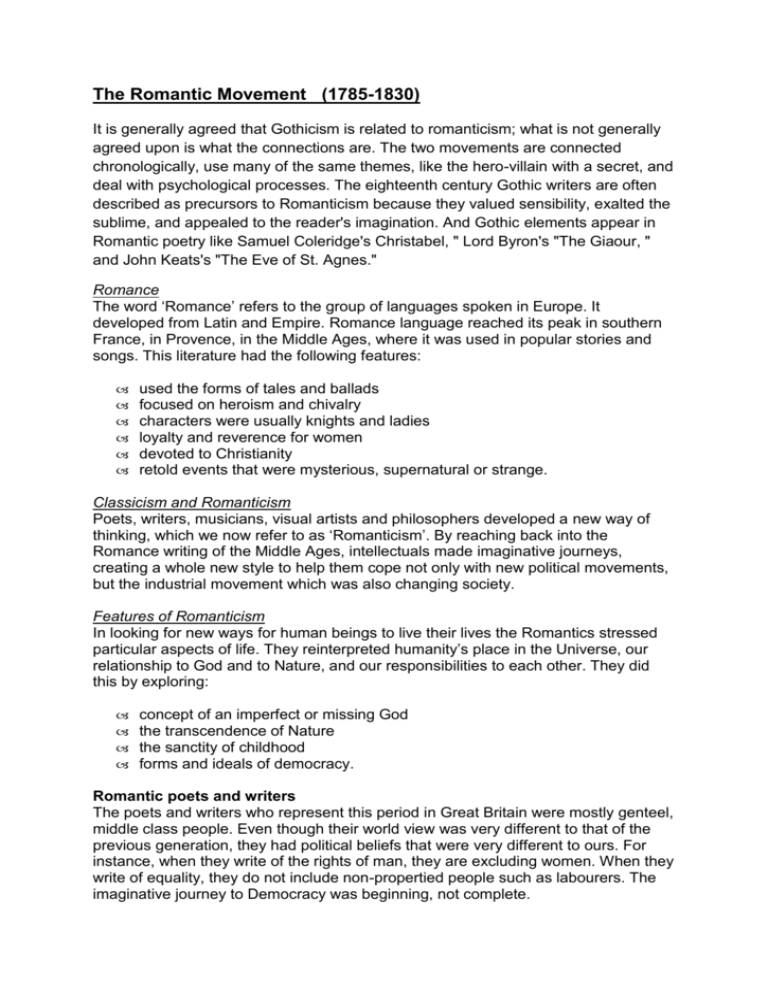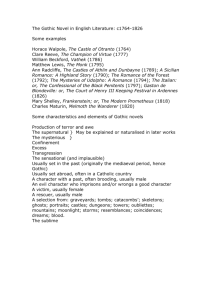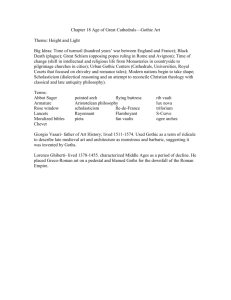Gothic tradition - weeping
advertisement

The Romantic Movement (1785-1830) It is generally agreed that Gothicism is related to romanticism; what is not generally agreed upon is what the connections are. The two movements are connected chronologically, use many of the same themes, like the hero-villain with a secret, and deal with psychological processes. The eighteenth century Gothic writers are often described as precursors to Romanticism because they valued sensibility, exalted the sublime, and appealed to the reader's imagination. And Gothic elements appear in Romantic poetry like Samuel Coleridge's Christabel, " Lord Byron's "The Giaour, " and John Keats's "The Eve of St. Agnes." Romance The word ‘Romance’ refers to the group of languages spoken in Europe. It developed from Latin and Empire. Romance language reached its peak in southern France, in Provence, in the Middle Ages, where it was used in popular stories and songs. This literature had the following features: used the forms of tales and ballads focused on heroism and chivalry characters were usually knights and ladies loyalty and reverence for women devoted to Christianity retold events that were mysterious, supernatural or strange. Classicism and Romanticism Poets, writers, musicians, visual artists and philosophers developed a new way of thinking, which we now refer to as ‘Romanticism’. By reaching back into the Romance writing of the Middle Ages, intellectuals made imaginative journeys, creating a whole new style to help them cope not only with new political movements, but the industrial movement which was also changing society. Features of Romanticism In looking for new ways for human beings to live their lives the Romantics stressed particular aspects of life. They reinterpreted humanity’s place in the Universe, our relationship to God and to Nature, and our responsibilities to each other. They did this by exploring: concept of an imperfect or missing God the transcendence of Nature the sanctity of childhood forms and ideals of democracy. Romantic poets and writers The poets and writers who represent this period in Great Britain were mostly genteel, middle class people. Even though their world view was very different to that of the previous generation, they had political beliefs that were very different to ours. For instance, when they write of the rights of man, they are excluding women. When they write of equality, they do not include non-propertied people such as labourers. The imaginative journey to Democracy was beginning, not complete. The Gothic tradition At the same time the Romantic writers were creating serious texts, popular writers were creating a new Gothic tradition. This form of literature was considered less serious than Romanticism but shared some features: Gothic vs. Romantic Gothic Setting: castle, sinister building, dungeon, cemetery, labyrinth, thick forest, extreme landscape, extreme weather, shadows, flickering candle, moonlight in the darkness Types of characters: a passion-driven, willful villain-hero or villain; a curious heroine that needs to be rescued; a hero whose true identity is revealed by the end Feelings evoked: atmosphere of mystery and suspense, sentimentality, fear, terror, sorrow, overwrought emotion, impeding doom, breathlessness and panic, anger Typical events/motifs: omens, curses, prophecies, supernatural manifestations, magic, visions, inexplicable events (ghosts/giants walking/coming to life) Romantic Setting: exotic locations, mountains, pastoral locations, picturesque landscapes Types of characters: a gifted, misunderstood dreamer; rebel against the society’s standard ways; egocentric plagued by guilt and remorse; heroic individualist; pioneer; young, passionate and ultra-sensitive artist; a passive woman with a traditional female role of wife/daughter, often need to be rescued; orphan. Feelings evoked: love, terror, rage, affection, sorrow, longing, and empathy for others. Typical events/motifs: traveling; ancient myths; nature as a powerful force or soothing, restorative influence of nature; romantic love; value of imagination over intellect; nature used to foreshadow events. Approaching the Gothic Tradition The historical context Historically the Goths were one of several Germanic tribes instrumental in the disintegration of the Roman Empire in the 4th Century. In the following centuries historians began to regard the Goths as all Germans- including the Anglo-Saxons who settled in the British Isles. Politically they were seen as a ‘native freedom loving’ people in contrast to the ‘foreign imperialistic’ Normans who invaded in 1066. By the 18th century, when agitation for political and social reform was brewing, this idea of the freedom loving gothic tradition was used to fight against the authoritarian monarchy. Gothic came to mean ‘medieval’ and a return to a tradition which valued feelings and sensibility, which had been largely dismissed as the world view at this time centred on reason as the key to all human problems. Reason and rationality had become part of the world view during the period of Enlightenment. This was a move away from superstition and blind adherence to tradition in favour of scientific enquiry. The period of Enlightenment in the 18th century was a time of social progress, scientific and technological innovation, and political and social stability. Middle class readers could feel safe and secure in their worlds while indulging in the thrill of gothic horror and becoming more in touch with feeling and emotion instead of relying on reason to rule their world. The first text which is considered gothic was a novel by Horace Walpole’s The Castle of Otranto (1764) although Shakespeare’s Macbeth and a number of other novels and poems written before this time also have gothic elements. Gothic Influences The gothic tradition showed itself first not in literature but in art, architecture and landscape gardening. These manifestations of the gothic; however were more aimed at the aristocracy as they were expensive art forms. Widening literacy, especially among the middle class, meant that gothic literature was embraced especially by women. One of the fist areas to show the gothic influence was art. Gothic art was in opposition to the ‘Neo-Classical’ art form of the 17th and 18th century. NeoClassic art focused on the rational, good order, good taste and the aesthetically pleasing. One of the first gothic masterpieces is Goya’s The Sleep of Reason Produces Monsters. It depicts a sleeping man slumped on a desk being threatened by blood sucking bats and surrounded by darkness. The message of the picture is that when reason sleeps the repressed monsters will rise. This idea was taken up by Freud a hundred years later in his writing about the damage of psychological repression and its effect on mental health. Goya - Sleep of Reason (1799) Henry Fuseli- The Nightmare (1782) Throughout the 18th Century, wealthy aristocratic patrons commissioned many gothic buildings and landscapes. ‘Ruined’ castles, gardens with dead trees, gargoyles, vaulted arches were recreated on patrons’ wealthy estates. Horace Walpole commissioned a home ‘Strawberry Hills’ that was a gothic masterpiece at the time. Strawberry Hills The Political Context The height of the gothic period was between 1750 and 1820 (although Gothic influences are seen in literature up until contemporary times). During the period 1750-1820 there was an acceleration of change in just about every sphere of human activity. In 1776 the American colonies issued the Declaration of Independence, provoking the War of Independence. In 1783 America was recognized as independent by Great Britain. In 1789 the French people overthrew their King and established rule by the people. This sent shock waves around the world. These were dangerous times. Revolts in some countries encouraged governments such as Great Britain, to react harshly to writers considered to be unpatriotic or seditious. Fred Botting has written that, “Uncertainties about the nature of power, law, society, family, marriage and sexuality dominate Gothic fiction...linked to wider threats of disintegration manifested most forcefully in political revolution” (Gothic: The New political Idiom, 1996). Interestingly many of these tensions are also evident in today’s society and may well explain the gothic’s continuing popularity. Uncertainty in how to visualise the future, revolutionary politicisation, overly emotional responses from extreme optimism to profound despair, nostalgia, and escapism were all evident in gothic texts. In Britain the expanding industries and transport systems were the basis of an emerging wealthy middle class. The middle class’ relationship with the working class – the people that made the middle class’ wealth achievable was also tempestuous. The political system changed very slowly and did not reflect this change in power. Changes in women’s status eg the sufferage movement were also starting to come to the fore. Many of these tensions manifested themselves in gothic texts. The Spiritual Context Spiritual uncertainty was also a characteristic of the 1750’s- 1820. The gothic was a ‘sudden dislocation, challenge to or loss of faith in the theological forces before there was a scientific one to replace it.” (Marilyn Gaull) Although most people still had religious belief in the idea of the Christian creed they had little idea of a spiritual sense of God. Gothic literature focuses on humanity’s fascination with the grotesque, the unknown, and the frightening, inexplicable aspects of the universe and the human soul. The Gothic creates horror by portraying human individuals in confrontation with the overwhelming, mysterious, terrifying forces found in the cosmos and within themselves. Gothic literature pictures the human condition as an ambiguous mixture of good and evil powers that cannot be understood completely by human reason. The Gothic perspective conceives of the human condition as a paradox, a dilemma of duality—humans are divided in the conflict between opposing forces in the world and in themselves. The Gothic themes of human nature’s depravity, the struggle between good and evil in the human soul, and the existence of unexplainable elements in humanity and the cosmos, are prominent themes. Gothic through the Ages There is no historical period to which the gothic can be assigned. Gothic texts have continued to be popular since the 1750’s. Whilst the gothic often conforms to particular conventions eg vampires, monsters some texts have no supernatural elements. The Yellow Wallpaper by Charlotte Perkins Gilman (1892), Rebecca by Daphne du Maurier (1938) are very different from Bram Stoker’s Dracula (1897) and Robert Louis Stevenson’s The Strange Case of Dr Jekyll and Mr Hyde (1866). Gothic or Horror? The definition of gothic is fairly loose; however Anne Radcliffe, a prolific 1790’s gothic writer, made the following distinction- horror exposes the reader to graphic depictions of violence and supernatural interventions whereas terror produces its effect through subtle stylistic techniques that suggest without ever overtly displaying objects and scenes of dread. This distinction still persists and is seen in psychological horror eg Alfred Hitchcock’s films rather than the graphic violence typical of ‘horror’ cinema. Bibliography Stevens, David. “The Gothic Tradition” Cambridge University Press, Melbourne, 2000. Chaplin, Sue. “Gothic Literature: Texts, Contexts, Connections” York Press, London, 2011.








